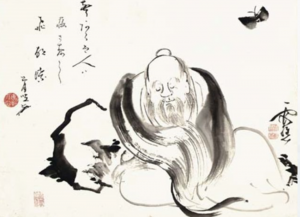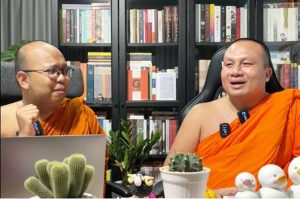
Editor’s note: This feature was first published in the now-retired Bodhi Journal, Issue 1, October 2006.
1. Introduction
This article features a brief explication of the doctrine of ‘dependant origination’ (pa?icca-samupp?da) and a discussion of its conceptual applications in early Buddhism. Regarding the latter, it primarily seeks to elaborate on the theory that dependant origination was described as the ‘middle doctrine’ (majjhima-dhamma) in the P?li Suttas in view of its providing a theoretical platform for Buddhism to transcend the key classical Indian philosophical conflict centered around the dichotomy of ‘eternalism’ (sassatav?da) and ‘annihilation-ism’ (ucchedav?da), as well as other important philosophical and religious controversies contemporaneous to the Buddha. Amongst the other philosophical controversies transcended by pa?icca-samupp?da, those that shall be focused on in this paper include several competing views regarding causation or origination, in particular; 1) Vassavativ?da and Satk?ryav?da, 2) the theory of self causation (saya?kata) as opposed to the doctrine of external causation (para?kata), and 3) contrast between the views of strict determination (niyativ?da) and fortuitous origination (addhiccasamuppanna). In addition, I will very briefly discuss some of the spiritual and moral implications of this ‘middle doctrine’ in terms of its underlying two important middle ‘ways’: a) avoiding the extremes of self mortification (attakilamath?nuyoga) and self-indulgence (k?masukhallikh?nuyoga) (with regards to the sassatav?da/ucchedav?dacontroversy), and; b) avoiding condoning both the ‘classism’ underlying India’s traditional Brahministic caste system and the radical revolutionary/anti institutional tendencies of some proponents of the Sama?a philosophical movement (with regards to different views regarding causation).

2. The Meaning, Significance and Applications of the Doctrine of Dependant Origination (pa?icca samupp?da)
2.1 The Status of the Doctrine of Dependant Origination in Early Buddhism
The theory of Dependant Origination has a central position in early Buddhism as both a defining attribute of Buddhist thought, and a principle theoretical tool that delves into the very heart of the Buddha’s soteriological mission. Sariputra is quoted in the P?li Suttas as stating: ‘Whoever understands the pa?icca samupp?da understands the Dhamma, and whoever understands the Dhamma understands the pa?icca samupp?da’ (Yo pa?icca-samupp?da? passati so dhamma? passati). Ny?n?tiloka similarly states that the comprehension of this doctrine constitutes ‘the indispensable condition for the real understanding and realization of the teaching of the Buddha’. This centrality indeed holds true for many other Buddhist traditions, with the doctrine having being described as possibly constituting ‘the common denominator of all the Buddhist traditions throughout the world, whether Mah?y?na of Therav?da.’
2.2 Definition and Core Meaning of the Doctrine of Pa?icca samupp?da
The doctrine of pa?icca samupp?da, which has been rendered in English as ‘arising on the ground of a preceding cause’ , is described in its core form in the P?li Suttas as follows:
Imasmin sati ida? hoti’
‘When this is present, that is present’
imass’upp?da ida? uppajjati
‘With the arising of this, that arises’
imasmin asati ida? na hoti
‘When this is absent, that does not come to be’
imassa nirodh? ida? nirujjhati
‘With the cessation of this, that ceases’
Describing this fourfold formulae in summary, Taiken Kamura states that ‘all phenomena are established through [a matrix of] interconnections; without these connections, nothing could be established’. The theory of Dependant Origination thus amounts to a statement of the ‘interdependence of all phenomena’, and as such, should not be thought of as a causal doctrine that deals with ‘origination’ in a strict ontological or cosmological sense. Indeed, Stcherbatsky states that according to this theory, phenomena can be described as being ‘coordinated’, rather than being ‘produced’ through some definitive process of creation, whilst Y. Karunadasa defines this theory as one of ‘conditionality’. These notions will be discussed in greater detail in the section concerning saya?kata and para?kata (theories of self and external causation respectively).
2.3 Theory and Application: Pa?icca samupp?da, its Relationship with the Twelve Link Dependant Origination Series, and its Expression in Buddhist Thought.
As pointed out by Karunadasa and recognized by a growing number of modern scholars, one common tendency in the interpretation of early Buddhism has been an inability to distinguish the theory of Dependant Origination from perhaps its most important conceptual application: the twelve link causal series (featuring the elements; ignorance (avijj?), volitional activities (sa?kh?ra), consciousness (vin?n????a), name and form (n?ma-r?pa), the sixfold base (sa??yatana), craving (phassa), clinging (vedan?), becoming (bhava), birth (j?ti), ageing and death (jar?mara??a- often quoted together with ‘sorrow, lamentation, pain, grief, and despair’). As pointed out by Ye Yuan-hou, ‘In interpretations of the doctrine of dependant origination, the twelve link dependant origination (dependant origination series) has almost substituted [all] other dependant origination series, [and] because of its unique and important position, it has drowned out other series’. This trend has indeed only relatively recently been reversed by modern scholars’ recognition of a range of other dependant origination series.
While it is certainly erroneous to equate the doctrine of Dependant Origination with the twelve link causal series, this tendency is nonetheless understandable. The reason for this, in line with the abovementioned point about the ‘centrality’ of this doctrine, most definitely lies in its strong connection with the fundamental Buddhist doctrine of the Four Noble Truths. Starting with ‘ignorance’ as its first and (essentially) ‘suffering’ as its last element, this chain is typically interpreted as describing the Second Noble Truth (samudaya – the arising [of suffering]), whilst also providing the theoretical foundation for the Third Noble Truth (nirodha – the cessation [of suffering]). As stated in the Kacc?vanagotta Sutra:
From ignorance as condition formations come to be; from formations as condition consciousness comes to be… such is the arising of this entire mass of suffering. From the complete fading away and cessation of that very ignorance, there comes to be the cessation of formations; from the cessation of formations, the cessation of consciousness… Such is the cessation of this entire mass of suffering.
Given the Four Noble Truths in a way defines the fundamental soteriological mission of the Buddha, it is thus not surprising that many would automatically associate the doctrine of Dependant Origination with the twelve link Dependant Origination series. Such an explanation indeed seems to help explain the statement ‘He who understands the doctrine of Dependant Origination understands the dhamma’; particularly in view of the fact that the Buddha stated his doctrine has ‘one taste, the taste of deliverance’ (ie, from suffering). Indeed, soon after the statement ‘Whoever understands the pa?icca samupp?da understands the Dhamma…’, a reference is made to this very chain (the links ‘grasping’ to ‘decay-and-death, sorrow, lamentation,’ etc.).
It should be noted, however, that the link between the notion of pa?icca samupp?da and the Buddhist purport of suffering and deliverance is much more multifaceted than can be encapsulated by this more specific twelve link dependant origination series. Indeed, Sue Hamilton’s statement in reference to the more core definition of the notion of pa?icca samupp?da given above, that ‘it is because all things are conditioned that they are impermanent…, it is because all conditioned things are impermanent that they are unsatisfactory’ , is a pertinent case in point. Yet the statement ‘He who understands the doctrine of dependant origination understands the dhamma’ takes on greater significance when we look at the pervasive application of this core theory, elucidated by the basic formulae ‘when this is present, that is present’ etc, in almost all other aspects of Buddhist thought. Indeed, this core theory of ‘conditionality’ is both a foundation and distinguishing characteristic of Buddhist ontology, epistemology, psychology and ethics. As stated by Y. Karunadasa, ‘it is on the basis of this principle (the above mentioned core definition of Dependant Origination) that Buddhism seeks to explain all its fundamental doctrines, such as the analysis of mind and the theory of perception, karma and the moral order and the nature of the empirical individuality and its samsaric dimension.’ Indeed, as the Buddha defined ‘deliverance’ as being the one ‘flavour’ of his doctrine, so may we define pa?icca-samupp?da as being the key ingredient that defines and distinguishes the aroma of the Buddhist teachings.
Importantly with regards to this ‘distinguishing’ attribute, it is also essentially on the basis of this doctrine of Dependant Origination that the Buddha had found a powerful tool to both respond to and transcend the diametrically opposed extreme theoretical positions of sassatav?da (eternalism) and ucchedav?da (view of annihilation); a contemporary controversy of great significance in the formation of Buddhist thought, and in addition derive new solutions to a variety of philosophical dichotomies defining many of the other philosophical/religious controversies of his time. As I shall now discuss, it is fundamentally in virtue of this ability to escape the constraining polarization of these contemporary controversies that the theory of Dependant Origination came to play an essential role in the formation of Buddhist ideology and identity, and came to be described with reverence in the Suttas as defining the Buddha’s ‘middle doctrine’.
3. Pa?icca samupp?da as the Middle Doctrine (1): Transcending the Mutual Conflict between Sassatav?da and Ucchedav?da
3.1 The Formation of Buddhism and Conflict between Sassatav?da and Ucchedav?da
It has been established by Y. Karunadasa that Buddhism arose as a critical response to the mutual conflict between two prevailing contemporary ideologies in India – that of the spiritualists and the materialists, known assassatav?da (eternalism) and ucchedav?da (view of annihilation = ‘annihilationism’) respectively. Due to constraints in time and space I will not describe them in detail here, however a brief overview of their fundamental positions is perhaps in order.
Sassatav?da refers to the spiritualist ideologies of India that held the view of a duality between the soul and the body (‘duality principle’), and that on the basis of purporting the liberation of the soul (ie, the ‘metaphysical self’) through resisting the ‘gravitational pull’ of the worldly body (ie, sensual desire and in some cases biological need), constituted the ideological basis underlying the extremely harsh Indian aesthetic practices amounting to self-mortification (attakilamath?nuyoga). In stark contrast with this position, the materialist view held that the body and the soul are one (identity principle/theory of the physical self), therefore denied the possibility of survival, and on the basis of this position promoted the enjoyment of temporal existence through unrestrained sensual indulgence (k?masukhallik?nuyoga). Seeking to avoid the extremes of self-mortification and self-indulgence inspired by these ideologies, the Buddha promoted a ‘Middle-Path’ (majjhim?-patipada) – known as the Eightfold Path, which purported that the way to spiritual liberation laid in practicing sensual restraint whilst avoiding bringing upon oneself the calamity of harsh and undue physical duress or injury.
In combating the unprofitable practices of self-mortification and uninhibited sensual indulgence, the Buddha had clearly perceived the fundamental need to respond to the ideological bases that underlined them. Thus just as the Buddha taught what he described as a ‘middle path’ (majjhima-pa?ipada) for the negotiation of these extreme practices, so also did he promote a theoretical foundation for this path, known as the ‘middle doctrine’ (majjhima dhamma), that in a similar way would transcend the two extremes of belief in absolute permanent existence (ie,sassatav?da) and the notion of impending non-existence through annihilation (ucchedav?da). This so called ‘middle doctrine’ is itself non other than the theory of Dependant Origination (pa?icca samupp?da).
3.2 Not-self, Dependant Origination and the Middle Way
As highlighted by Y. Karunadasa in his work ‘The Buddhist Critique of Sassatav?da and Ucchedav?da… ,’ the identification of pa?icca samupp?da as the ‘middle doctrine’ in the P?li Suttas arises in the context of a discussion concerning views representing sassatav?da (eternalism) and ucchedav?da (annihilationism). The following passage appears in the Kaccayanagotta Sutta of the Sa?yutta Nik?ya:
By and large, Kaccayana, this world is supported by (ie, takes as its object) a polarity, that of existence and non-existence. But when one sees the origination of the world as it actually is with right discernment, ‘non-existence’ with reference to the world does not occur to one. When one sees the cessation of the world as it actually is with right discernment, ‘existence’ with reference to the world does not occur to one.
By and large, Kaccayana, this world is in bondage to attachments, clingings (sustenances), & biases. But one such as this does not get involved with or cling to these attachments, clingings, fixations of awareness, biases, or obsessions; nor is he resolved on ‘my self.’ He has no uncertainty or doubt that what arises is just suffering; what passes away is just suffering. In this, his knowledge is independent of others. It’s to this extent, Kaccayana, that there is right view.
‘Everything exists’: that is one extreme. ‘Everything doesn’t exist’: that is a second extreme. Avoiding these two extremes, the Tath?gata teaches the Dhamma via the middle: From ignorance as a requisite condition come fabrications. From fabrications as a requisite condition comes consciousness. From consciousness as a requisite… From birth as a requisite condition, then aging & death, sorrow, lamentation, pain, distress, and despair come into play. Such is the origination of this entire mass of stress and suffering.”
What is interesting to note in this passage is the mention, in conjunction with this dichotomy describing thesassatav?da and ucchedav?da ideologies, of the notion of a fixation on the concept of a ‘self’ or ‘soul’ (?tman). Indeed, it is by means of this notion that the Buddha was able to discern a commonality between these apparently diametrically opposed viewpoints. Sassatav?da, (particularly in its Brahmin articulation), for instance, held the existence of ‘a permanent, self entity impervious to change’, and featuring ‘a spiritual substance… which relates… to some kind of transcendental reality serving as the ultimate ground of existence’. Although holding the view of the non-permanence or temporality of a being, ucchedav?da too can be seen to essentially agree with sassatav?da &











